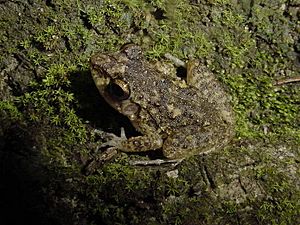Eleutherodactylus cuneatus facts for kids
Quick facts for kids Eleutherodactylus cuneatus |
|
|---|---|
 |
|
| Conservation status | |
| Scientific classification | |
| Synonyms | |
|
Eleutherodactylus brevipalmatus (Schmidt, 1920) |
The Eleutherodactylus cuneatus is a special type of frog. It belongs to a group of frogs called Eleutherodactylidae. This frog is found only in Cuba, which means it is endemic to that island. It was first described in 1862 by a scientist named Edward Drinker Cope.
Contents
Meet the Cuban Cuneatus Frog
The Eleutherodactylus cuneatus is a small frog that lives in many different places. It is known for its ability to live in both wild and human-made environments. This makes it a very adaptable creature.
Where Does This Frog Live?
This frog can be found in many types of natural areas. It likes warm, wet places. These include tropical forests, both in lowlands and on mountains. It also lives in moist shrublands and grasslands that get wet during certain seasons.
The Eleutherodactylus cuneatus is also comfortable living near people. You might find it in places like:
- Near rivers
- On farms where crops are grown (arable land)
- In fields where animals graze (pastureland)
- In areas with many trees planted for wood or fruit (plantations)
- In gardens in the countryside
- Even in urban areas, like cities and towns
- In areas where forests used to be, but are now changed by humans
This frog is very good at finding a home in many different surroundings.
What Makes This Frog Special?
Frogs in the Eleutherodactylus family are sometimes called "rain frogs" or "direct-developing frogs." This is because they do not need water to lay their eggs. Unlike many other frogs, their eggs hatch directly into tiny froglets. There is no tadpole stage. This unique way of developing helps them survive in different habitats.
The Eleutherodactylus cuneatus is an important part of Cuba's wildlife. It helps keep the balance in its ecosystem. Scientists continue to study these frogs to learn more about them.
See also
 In Spanish: Eleutherodactylus cuneatus para niños
In Spanish: Eleutherodactylus cuneatus para niños


